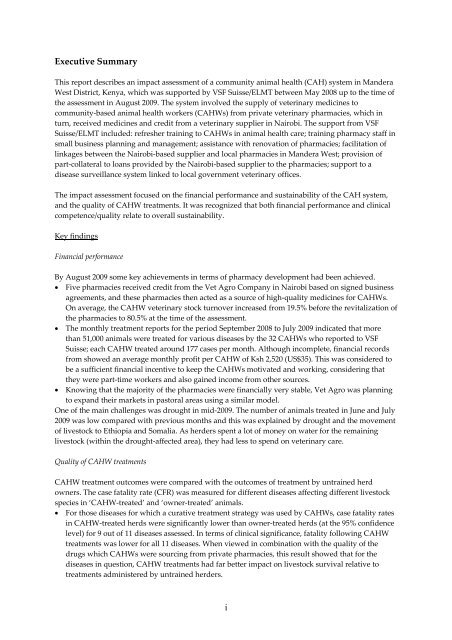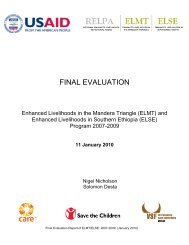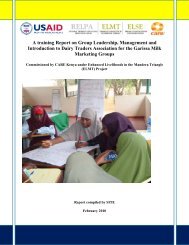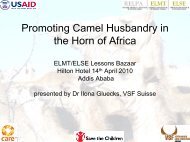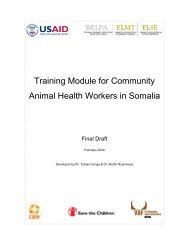Impact Assessment of the Community Animal Health System in ...
Impact Assessment of the Community Animal Health System in ...
Impact Assessment of the Community Animal Health System in ...
You also want an ePaper? Increase the reach of your titles
YUMPU automatically turns print PDFs into web optimized ePapers that Google loves.
Executive Summary<br />
This report describes an impact assessment <strong>of</strong> a community animal health (CAH) system <strong>in</strong> Mandera<br />
West District, Kenya, which was supported by VSF Suisse/ELMT between May 2008 up to <strong>the</strong> time <strong>of</strong><br />
<strong>the</strong> assessment <strong>in</strong> August 2009. The system <strong>in</strong>volved <strong>the</strong> supply <strong>of</strong> veter<strong>in</strong>ary medic<strong>in</strong>es to<br />
community‐based animal health workers (CAHWs) from private veter<strong>in</strong>ary pharmacies, which <strong>in</strong><br />
turn, received medic<strong>in</strong>es and credit from a veter<strong>in</strong>ary supplier <strong>in</strong> Nairobi. The support from VSF<br />
Suisse/ELMT <strong>in</strong>cluded: refresher tra<strong>in</strong><strong>in</strong>g to CAHWs <strong>in</strong> animal health care; tra<strong>in</strong><strong>in</strong>g pharmacy staff <strong>in</strong><br />
small bus<strong>in</strong>ess plann<strong>in</strong>g and management; assistance with renovation <strong>of</strong> pharmacies; facilitation <strong>of</strong><br />
l<strong>in</strong>kages between <strong>the</strong> Nairobi‐based supplier and local pharmacies <strong>in</strong> Mandera West; provision <strong>of</strong><br />
part‐collateral to loans provided by <strong>the</strong> Nairobi‐based supplier to <strong>the</strong> pharmacies; support to a<br />
disease surveillance system l<strong>in</strong>ked to local government veter<strong>in</strong>ary <strong>of</strong>fices.<br />
The impact assessment focused on <strong>the</strong> f<strong>in</strong>ancial performance and susta<strong>in</strong>ability <strong>of</strong> <strong>the</strong> CAH system,<br />
and <strong>the</strong> quality <strong>of</strong> CAHW treatments. It was recognized that both f<strong>in</strong>ancial performance and cl<strong>in</strong>ical<br />
competence/quality relate to overall susta<strong>in</strong>ability.<br />
Key f<strong>in</strong>d<strong>in</strong>gs<br />
F<strong>in</strong>ancial performance<br />
By August 2009 some key achievements <strong>in</strong> terms <strong>of</strong> pharmacy development had been achieved.<br />
• Five pharmacies received credit from <strong>the</strong> Vet Agro Company <strong>in</strong> Nairobi based on signed bus<strong>in</strong>ess<br />
agreements, and <strong>the</strong>se pharmacies <strong>the</strong>n acted as a source <strong>of</strong> high‐quality medic<strong>in</strong>es for CAHWs.<br />
On average, <strong>the</strong> CAHW veter<strong>in</strong>ary stock turnover <strong>in</strong>creased from 19.5% before <strong>the</strong> revitalization <strong>of</strong><br />
<strong>the</strong> pharmacies to 80.5% at <strong>the</strong> time <strong>of</strong> <strong>the</strong> assessment.<br />
• The monthly treatment reports for <strong>the</strong> period September 2008 to July 2009 <strong>in</strong>dicated that more<br />
than 51,000 animals were treated for various diseases by <strong>the</strong> 32 CAHWs who reported to VSF<br />
Suisse; each CAHW treated around 177 cases per month. Although <strong>in</strong>complete, f<strong>in</strong>ancial records<br />
from showed an average monthly pr<strong>of</strong>it per CAHW <strong>of</strong> Ksh 2,520 (US$35). This was considered to<br />
be a sufficient f<strong>in</strong>ancial <strong>in</strong>centive to keep <strong>the</strong> CAHWs motivated and work<strong>in</strong>g, consider<strong>in</strong>g that<br />
<strong>the</strong>y were part‐time workers and also ga<strong>in</strong>ed <strong>in</strong>come from o<strong>the</strong>r sources.<br />
• Know<strong>in</strong>g that <strong>the</strong> majority <strong>of</strong> <strong>the</strong> pharmacies were f<strong>in</strong>ancially very stable, Vet Agro was plann<strong>in</strong>g<br />
to expand <strong>the</strong>ir markets <strong>in</strong> pastoral areas us<strong>in</strong>g a similar model.<br />
One <strong>of</strong> <strong>the</strong> ma<strong>in</strong> challenges was drought <strong>in</strong> mid‐2009. The number <strong>of</strong> animals treated <strong>in</strong> June and July<br />
2009 was low compared with previous months and this was expla<strong>in</strong>ed by drought and <strong>the</strong> movement<br />
<strong>of</strong> livestock to Ethiopia and Somalia. As herders spent a lot <strong>of</strong> money on water for <strong>the</strong> rema<strong>in</strong><strong>in</strong>g<br />
livestock (with<strong>in</strong> <strong>the</strong> drought‐affected area), <strong>the</strong>y had less to spend on veter<strong>in</strong>ary care.<br />
Quality <strong>of</strong> CAHW treatments<br />
CAHW treatment outcomes were compared with <strong>the</strong> outcomes <strong>of</strong> treatment by untra<strong>in</strong>ed herd<br />
owners. The case fatality rate (CFR) was measured for different diseases affect<strong>in</strong>g different livestock<br />
species <strong>in</strong> ‘CAHW‐treated’ and ‘owner‐treated’ animals.<br />
• For those diseases for which a curative treatment strategy was used by CAHWs, case fatality rates<br />
<strong>in</strong> CAHW‐treated herds were significantly lower than owner‐treated herds (at <strong>the</strong> 95% confidence<br />
level) for 9 out <strong>of</strong> 11 diseases assessed. In terms <strong>of</strong> cl<strong>in</strong>ical significance, fatality follow<strong>in</strong>g CAHW<br />
treatments was lower for all 11 diseases. When viewed <strong>in</strong> comb<strong>in</strong>ation with <strong>the</strong> quality <strong>of</strong> <strong>the</strong><br />
drugs which CAHWs were sourc<strong>in</strong>g from private pharmacies, this result showed that for <strong>the</strong><br />
diseases <strong>in</strong> question, CAHW treatments had far better impact on livestock survival relative to<br />
treatments adm<strong>in</strong>istered by untra<strong>in</strong>ed herders.<br />
i


